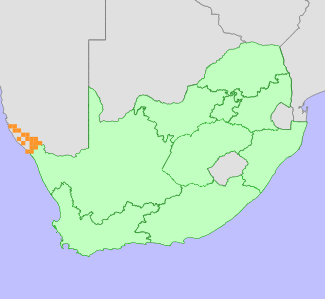|
Scientific Name | Dracophilus dealbatus (N.E.Br.) Walgate |
Higher Classification | Dicotyledons |
Family | AIZOACEAE |
Synonyms | Dracophilus montis-draconis (Dinter) Dinter & Schwantes, Dracophilus proximus (L.Bolus) Walgate, Juttadinteria proxima L.Bolus |
National Status |
Status and Criteria | Critically Endangered A4ace |
Assessment Date | 2022/06/03 |
Assessor(s) | P.C.V. Van Wyk, D. Raimondo & N.A. Helme |
Justification | The species is experiencing a rapid population decline, with 60-80% of the population observed to have declined between 2015 and 2022. Climate models predict ongoing aridification within the species' range. Given that species in the family Aizoaceae have limited seed dispersal and require reliable rainfall over multiple consecutive years for successful recruitment, it is suspected that this species' population will decline by a further 50% by 2050 (generation length is 30 years). Additionally, it faces a serious potential threat of habitat loss due to green hydrogen projects. As a result, it qualifies for listing as Critically Endangered under criterion A.
This species also occurs in Namibia; however, the subpopulations there are also declining due to drought and mining impacts. The regional status is therefore not downgraded. |
Distribution |
Endemism | Not endemic to South Africa |
Provincial distribution | Northern Cape |
Range | It occurs in both South Africa and Namibia and is found in the Western Gariep Desert vegetation of South Africa and in the Sperrgebiet region of Namibia. |
Habitat and Ecology |
Major system | Terrestrial |
Major habitats | Northern Richtersveld Yellow Duneveld, Western Gariep Hills Desert, Western Gariep Lowland Desert, Western Gariep Plains Desert |
Description | It grows in alluvial gravel and sand deposits in wind corridors, and does not occur in river beds nor on mountains and hills. |
Threats |
| This species has experienced severe declines since 2015 due to the worst drought on record. Predictions of future climate change include further increases in the annual average temperature, ranging between 1.4°C and 2.4°C by 2050. This rise is expected to lead to unbearably hot temperatures throughout significant portions of the year (van Wilgen, 2017). Population decline due to drought is therefore highly likely to persist. Its habitat in the Northern Cape has also been degraded by overgrazing and trampling by livestock which was particularly bad between 2002 and 2015, and would again intensify should rain be received in any part of its range in South Africa. This species is mostly restricted to plains and terraces containing diamonds in both South Africa and Namibia. It has already lost its habitat to mining and this loss will continue as mining operations expand their footprints. In southern Namibia, and northern South Africa the subpopulation close to the Orange River has already been affected by diamond mining and this threat is likely to increase in the future should green hydrogen projects, such as solar arrays and wind farms, currently being scoped for feasibility proceed in both Namibia and South Africa. An estimated 50% of this species' habitat will be irreversibly modified across its range. |
Population |
This species has been recorded in between 18 and 25 subpopulations. In spite of this, the population is rapidly declining, primarily because of droughts and habitat loss caused by mining. In South Africa, there used to be over 1 million plants; however, now only between 2000 and 4000 mature individuals are likely to exist. The size of the subpopulations and their current status in Namibia are unknown.
|
Population trend | Decreasing |
Assessment History |
Taxon assessed |
Status and Criteria |
Citation/Red List version | | Dracophilus dealbatus (N.E.Br.) Walgate | Least Concern | Raimondo et al. (2009) | |
Bibliography |
Raimondo, D., von Staden, L., Foden, W., Victor, J.E., Helme, N.A., Turner, R.C., Kamundi, D.A. and Manyama, P.A. 2009. Red List of South African Plants. Strelitzia 25. South African National Biodiversity Institute, Pretoria.
Snijman, D.A. 2013. Plants of the Greater Cape Floristic Region 2: The extra Cape flora. Strelitzia 30. South African National Biodiversity Institute, Pretoria.
Van Wilgen, N.J. and Herbst, M. 2017. Taking stock of parks in a changing world: The SANParks Global Environmental Change Assessment. SANParks, Cape Town.
|
Citation |
| Van Wyk, P.C.V., Raimondo, D. & Helme, N.A. 2022. Dracophilus dealbatus (N.E.Br.) Walgate. National Assessment: Red List of South African Plants version . Accessed on 2025/07/26 |
 Comment on this assessment
Comment on this assessment


